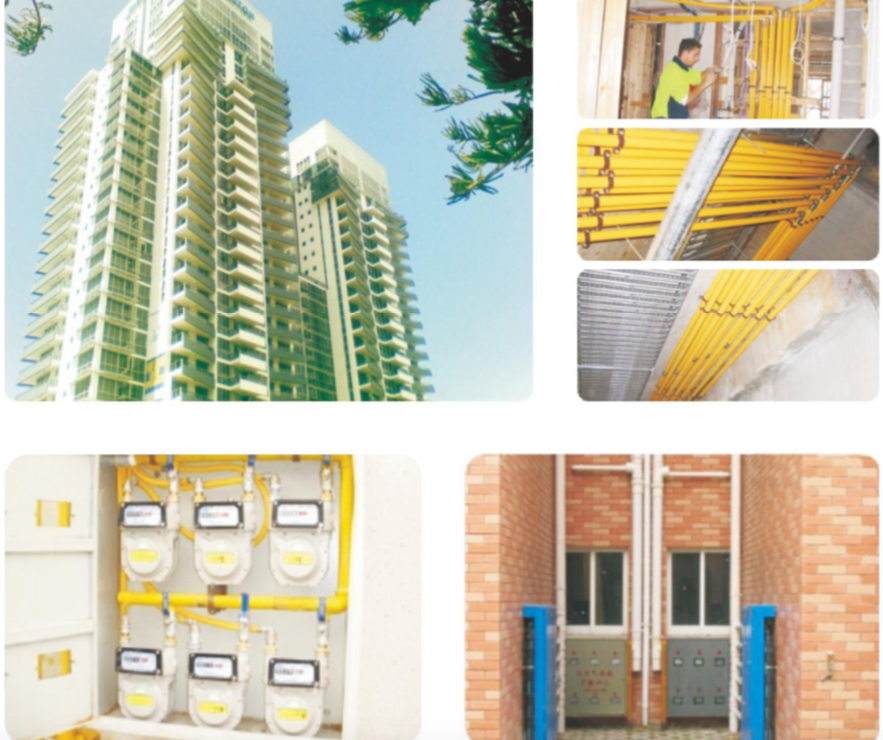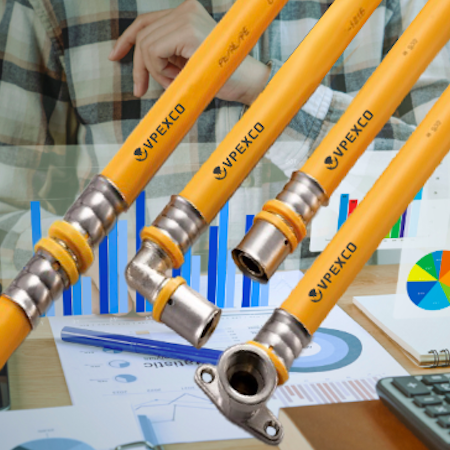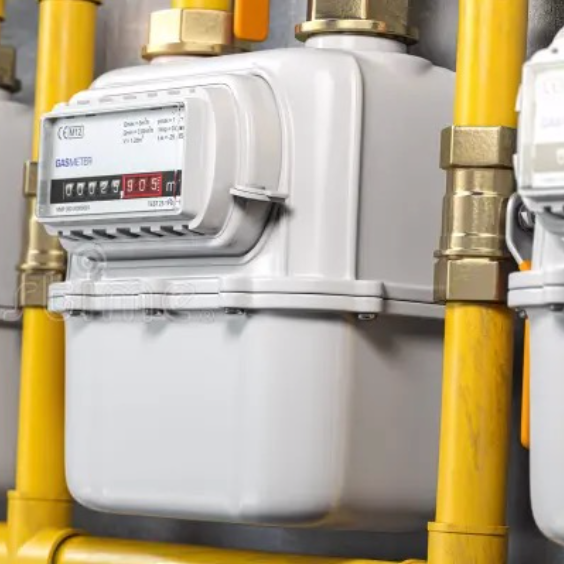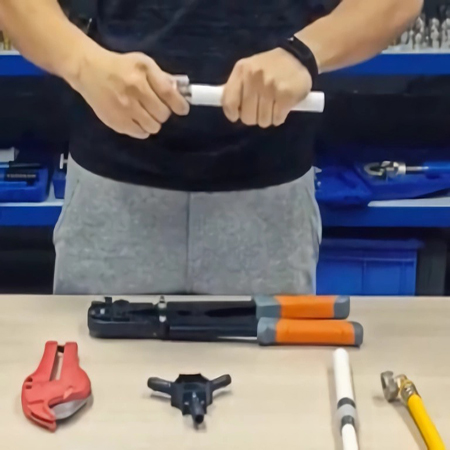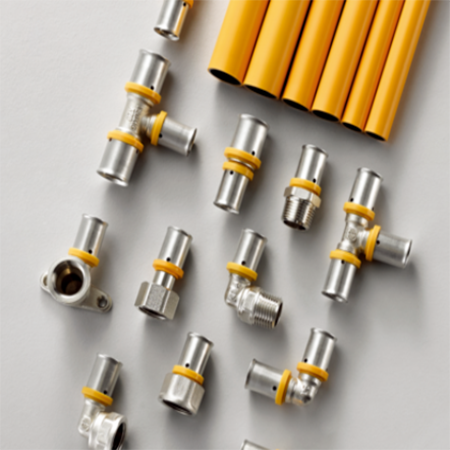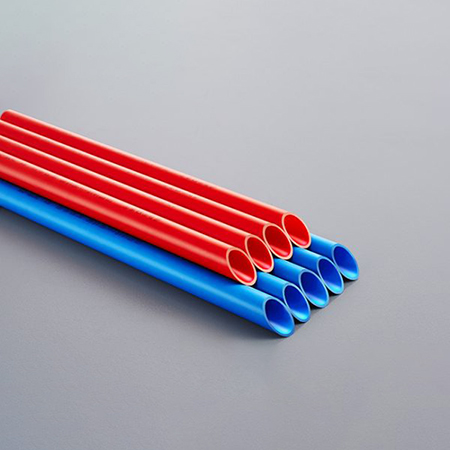Table of Contents
ToggleIntroduction
Definition and brief overview of PEX-AL-PEX gas pipes
PEX-AL-PEX pipes, also known as multilayer or composite pipes, are a type of piping that combine the benefits of metal and plastic piping. They are composed of three layers: an inner layer of cross-linked polyethylene (PEX), a middle layer of aluminum, and an outer layer of PEX. The layers are bonded together by a special adhesive to prevent delamination, thereby forming a single, sturdy pipe.
This composition provides several advantages:
1. The PEX layers give the pipe the flexibility and corrosion resistance of plastic. This flexibility makes the pipe easy to install even in complex configurations, while the corrosion resistance ensures the pipe’s longevity.
2. The aluminum layer gives the pipe the strength and rigidity of metal, helping it maintain its shape after bending or installation. It also serves as an impenetrable barrier to oxygen and other gases, reducing the risk of gas leaks.
3. The combination of different layers allows PEX-AL-PEX pipes to withstand higher temperatures and pressures compared to single material pipes.
Overall, PEX-AL-PEX gas pipes provide a high-performance, durable, and flexible option for gas systems, making them a popular choice in both residential and commercial applications. It’s important to note that any installation or maintenance work involving these pipes should be carried out by a qualified professional, following all local codes and regulations to ensure safety.
Importance of choosing the right gas piping material
Choosing the right gas piping material is of utmost importance, not only for the efficient operation of your gas appliances but also for the safety and longevity of your gas systems. Here’s why:
1. Safety: The primary concern with any gas system is safety. You want a material that is sturdy, reliable, and resistant against damage such as leaks or bursts. Some materials, like PEX-AL-PEX, have built-in barriers against gas permeation, significantly reducing the risk of gas leaks.
2. Durability: Over time, some pipe materials can corrode, deteriorate, or become damaged. A material like PEX-AL-PEX is resistant to corrosion and can withstand higher pressures, ensuring a longer lifespan for your pipes.
3. Efficiency: Good gas pressure is essential for the effective operation of your gas appliances. The right piping material can provide consistent and reliable gas pressure, while a poor choice can lead to pressure drops or inconsistent gas delivery.
4. Installation: Some materials are easier to install than others. Flexible materials like PEX-AL-PEX can be installed more easily over complex pathways and require fewer fittings, potentially reducing installation costs and time.
5. Maintenance: Over the long term, the right choice of piping material can reduce the number of repairs and replacements, saving you money. It’s also a good idea to choose a material for which parts are readily available and maintenance is well understood by professionals.
6. Environmental Impact: Some materials are more environmentally friendly than others. Choosing a longer-lasting, low maintenance material has a lower impact on the environment over its lifespan.
Keep these factors in mind when selecting piping material for your gas system. Always consult a professional to guide you in making the right choice for your specific circumstances and ensure compliance with local codes and regulations.
Overview of Traditional Gas Piping Materials
Common materials used in traditional gas piping
Traditional gas piping materials are typically metal-based, but advancements have been made in incorporating plastic materials for certain applications. Here are some traditional gas piping materials categorized into plastic and metal:
A. Plastic Gas Piping Materials:
Polyethylene (PE):
Advantages: Lightweight, flexible, and resistant to corrosion.
Applications: Used for natural gas distribution in some outdoor and underground installations.
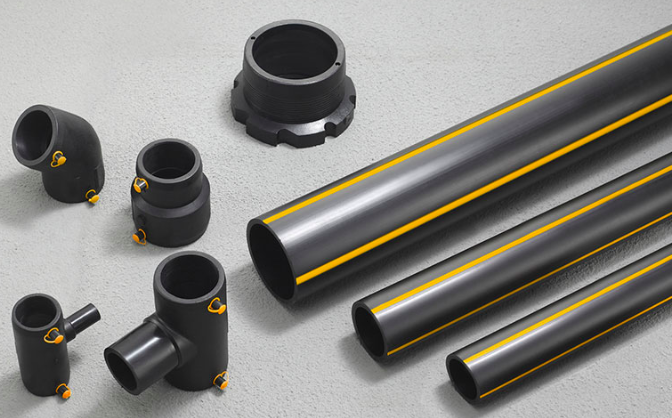
Polyvinyl Chloride (PVC):
Advantages: Lightweight, affordable, and corrosion-resistant.
Applications: Commonly used for natural gas distribution in outdoor and underground installations.
B. Metal Gas Piping Materials:
Steel:
Advantages: Durable and very, suitable for high pressure use.
Disadvantages: Susceptible to corrosion over time.
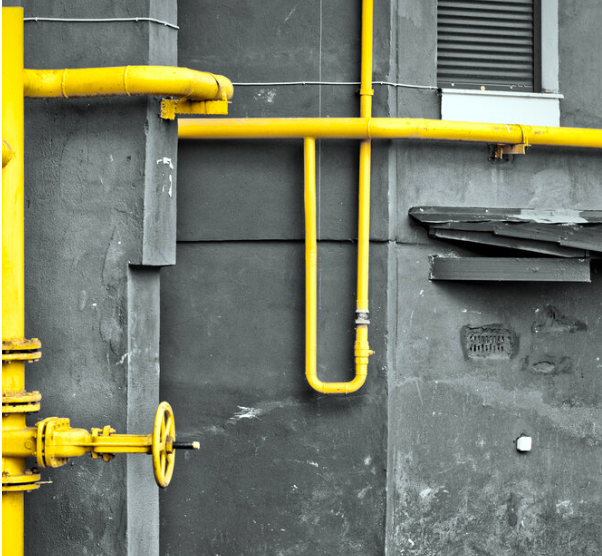
Copper:
Advantages: Corrosion-resistant, easy to install, and has a long lifespan.
Disadvantages: More expensive than some alternatives.

Iron:
Advantages: Strong and durable.
Disadvantages: Prone to corrosion, can be heavy and challenging to install.
Galvanized Steel:
Advantages: Resistant to corrosion due to the galvanization process.
Disadvantages: The zinc coating may wear away over time, leading to corrosion.
It’s important to note that while plastic materials have been used in some gas piping applications, metal materials remain prevalent due to their durability and ability to withstand high pressures. Additionally, plastic piping materials must comply with local building codes and standards to ensure safe and reliable gas distribution. Advances in technology have also led to the development of composite materials, such as PEX-AL-PEX, which combines the benefits of metal and plastic for improved performance in gas piping systems.
Comparative Analysis
Strengths and weaknesses of PEX-AL-PEX
As with any material chosen for specific applications, the PEX-AL-PEX pipes come with their own distinct set of strengths and weaknesses. This composite pipe, tailored to perform effectively in gas systems, offers cost-effectiveness, remarkable longevity and performance, and unparalleled installation flexibility. However, it’s essential to also consider its limitations to make an informed decision.
A. Cost-Effectiveness:
PEX-AL-PEX pipes are considered a cost-effective choice for gas systems, despite their slightly higher up-front cost compared to other materials. Their cost-effectiveness largely comes from their long-term merits, including a long lifespan, lower maintenance needs, and cheaper installation costs. By choosing PEX-AL-PEX pipes, homeowners and industry professionals can anticipate reduced overall system expenses due to fewer leaks, less frequent replacements, and potential reduced labor costs due to its ease of installation.
B. Longevity and Performance:
The innovative multi-layered structure of PEX-AL-PEX pipes – an outer, inner layer of PEX, and an interlinked core of aluminum – contributes significantly to their long-term reliability and exceptional performance. The aluminum core delivers robustness and shape retention. Additionally, it serves as an impervious oxygen barrier, reducing the risk of gas leaks and ensuring stable pressure for efficient operation. This construction also has the advantage of corrosion resistance, enhancing the durability of pipelines, whether used residentially or industrially.
C. Installation Flexibility:
One of the significant strengths of PEX-AL-PEX pipes is their remarkable installation flexibility, primarily attributable to the PEX layers. Its flexibility enables installation in complex configurations and tight spaces where other materials may struggle. The reduced need for fittings and the achievable continuity of long runs lead to fewer joints, lowering the likelihood of leaks. This trait, along with its reduced weight compared to metals, makes the PEX-AL-PEX pipe an attractive choice for contractors.
Despite these significant strengths, it is also crucial to bear in mind the limitations of PEX-AL-PEX pipes. The installation process calls for specialized tools and a skilled hand for cutting, bending, and connecting the pipes. This requirement may raise the expense and complexity of installation if such expertise is not readily available. Some regions may also restrict the use of PEX-AL-PEX, significant to consider while planning for pipe installation.
In conclusion, while PEX-AL-PEX boasts cost-effectiveness, longevity, performance, and installation flexibility, careful thought should be given to its limitations, ensuring the right material choice for your gas system needs. As always, consulting a professional will provide a more precise understanding of how well PEX-AL-PEX can serve your specific needs.
Strengths and weaknesses of traditional materials
Gas piping materials play a critical role in the functioning, safety, and efficiency of residential and industrial gas systems. Among the traditional materials, steel, copper and plastic are widely used, each presenting their own unique set of strengths and weaknesses. This article offers a broad perspective on these materials focusing on cost considerations, durability and maintenance, and installation challenges.
A. Cost considerations
1. Steel: For decades, steel has been the preferred choice for high-pressure applications due to its strength. However, this strength also comes with a price; steel pipes generally cost more than other materials. Additionally, the installation cost can be high because of the requirement for more fittings and its rigid nature.
2. Copper: Copper is a mid-range option when it comes to cost. It is less expensive than steel but costlier than plastic pipes. Copper’s average cost and semi-flexibility make it a good choice for smaller gas systems where high pressure isn’t a concern.
3. Plastic: Plastic pipes are the most affordable of the three, both in terms of purchase price and installation costs. Their flexibility allows for less complicated and faster installations, meaning a shorter, less costly installation process.
B. Durability and Maintenance:
1. Steel: Steel’s standout feature is its strength, which contributes to its durability. It is heat resistant and can withstand high pressure. However, steel’s biggest drawback is its susceptibility to corrosion over time, particularly in humid conditions, which may cause leaks and require more frequent maintenance.
2. Copper: Copper pipes offer a reasonable level of durability and are resistant to corrosion. However, they can’t handle the same pressure levels as steel, hence more suitable for systems with moderate or low gas pressure.
3. Plastic: While plastic pipes are resistant to corrosion, they lack the strength of steel and copper and may not be suitable for high-pressure gas lines. However, they provide a decent lifespan in systems with less demanding conditions.
C. Installation Challenges:
1. Steel: Installing steel pipes can be challenging due to their rigidity. They are heavy and require more fittings, which can make the installation process complex and time-consuming.
2. Copper: Although copper is somewhat flexible and easier to install compared to steel, it’s still not easy to work with in complex installations.
3. Plastic: Plastic pipes are highly flexible and can be easily installed even in complex setups. However, their flexibility can also be a downside in situations requiring a rigid pipe structure.
In conclusion, the selection of the right gas piping material requires a thorough understanding of the system’s specific needs and the materials’ strengths and limitations. Careful consideration of factors such as cost, durability, maintenance requirements, and installation challenges, in conjunction with local building codes and regulations, ensures a more reliable, safe, and efficient gas system. It’s always advisable to consult with a professional for a meticulous analysis and guidance based on the unique characteristics of each gas system.
Safety Considerations
Safety Features of PEX-AL-PEX
Regardless of the application, safety considerations indubitably occupy the top spot when choosing gas piping materials. Herein, we delve into an examination of the safety features and considerations around dominant piping solutions: PEX-AL-PEX and traditional materials like steel, copper, and plastic.
A. Resistance to Leaks: One of the standout features of PEX-AL-PEX pipes is their high resistance to leaks. This can be attributed to their construction – PEX layers offer flexibility while the core aluminum layer provides the rigidity, enabling this material to withstand numerous external and internal pressures, thereby leading to fewer leaks over time.
B. Corrosion Resistance: PEX-AL-PEX pipes are impressively resistant to corrosion. The plastic components (PEX layers) stand up well to various forms of chemical corrosion, unlike metals. The combination of aluminum and PEX also effectively resists galvanic and electrolytic corrosion, considerably extending the lifespan of the gas system.
C. Compliance with Safety Standards: PEX-AL-PEX pipes are manufactured to comply with all relevant safety regulations, ensuring they are fit for purpose. These pipes undergo stringent testing to ensure operational reliability under a range of conditions, which aids in maintaining safety standards.
Safety Considerations with Traditional Materials
A. Potential for Leaks and Corrosion: Traditional materials, like steel and copper, if not well-maintained, have a higher potential for corrosion, which can subsequently lead to leakages. While copper demonstrates superior corrosion resistance than steel, both are still vulnerable to certain types of corrosion over time. Plastic, on the other hand, is highly corrosion-resistant but can cause concerns around the durability and longevity of gas lines subjected to high pressure.
B. Compliance with Safety Regulations: Traditional materials also comply with safety regulations, but the inherent properties and maintenance requirements of these materials may indirectly affect safety. For instance, due to their proneness to corrosion and leaks, steel and copper pipes may require more frequent inspections to ensure their integrity and therefore, safe operation.
Case Studies and Real-world Examples
Success stories of PEX-AL-PEX gas pipe applications
Over time, more and more professionals in the gas delivery industry have turned to PEX-AL-PEX pipes due to their unique qualities that make them ideal for various applications. There have been countless success stories, but let’s delve into some notable real-world applications that highlight the benefits of this composite material.
I. Residential Application: One homeowner had struggled with old, worn out steel pipes in her heritage home, leading to low gas pressure and increasing safety concerns. After extensive research and careful consideration, PEX-AL-PEX pipes were chosen for their gas line upgrade. The pipes’ flexibility made it easier to navigate through the house’s tight spaces and intricate layout. The result? The residence now enjoys consistently high gas pressure, with zero leaks detected since the upgrade.
II. Industrial Application: A large manufacturing plant faced massive renovation, including its gas delivery lines. The plant’s old copper and steel pipes had substantially corroded over the years, causing numerous leaks and lowered efficiency. By switching to PEX-AL-PEX pipes, the manufacturing plant was able to withstand extreme conditions, and the material’s superior durability minimized maintenance. Consequently, the plant significantly reduced downtimes and enjoyed uninterrupted operations, saving both time and resources.
III. Educational Institution: A significant university embarked on a substantial redevelopment project across its sprawling campus. The project included updating the outdated gas system. Given the sheer scale of the project, the university’s contractors chose PEX-AL-PEX pipes for their ease of installation and cost-effectiveness. Its resistance to oxygen permeation ensured the campus-wide gas heating system worked efficiently, providing the institution with peace of mind about safety and reliability.
IV. Restaurant Chains: Restaurant chains, which heavily depend on effective gas systems for their everyday cooking needs, have also witnessed the benefits of switching to PEX-AL-PEX. One such chain upgraded its gas piping system to PEX-AL-PEX and successfully minimized the risk of leakages, resulting in safer operations. The chain also experienced a significant reduction in gas supply downtime, allowing for smoother restaurant operations.
These success stories bear testament to PEX-AL-PEX pipes’ vast potential in delivering efficient, safe, and cost-effective gas systems. Regardless of the specific need or setting, PEX-AL-PEX pipes continue to affect beneficial transformations across the globe. As technology advances, we can expect even more innovative and effective applications of this remarkable material.
Conclusion
In conclusion, ensuring the safety of gas systems involves careful consideration of the material properties and potential maintenance requirements. With their remarkable resistance to leaks, corrosion resistance, and concrete adherence to safety regulations, PEX-AL-PEX pipes present compelling safety benefits. That said, this doesn’t mean traditional materials are without their merits. However, choosing the best-fit material demands a comprehensive understanding of the nuances of each material touched upon in this article, combined with an evaluation of the specific needs and requirements of the gas system. As always, consulting with professional installers or engineers
familiar with these systems can provide a wealth of personalized advice and expertise.
For more information, welcome to contact export@vpexco.co




